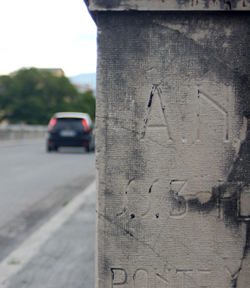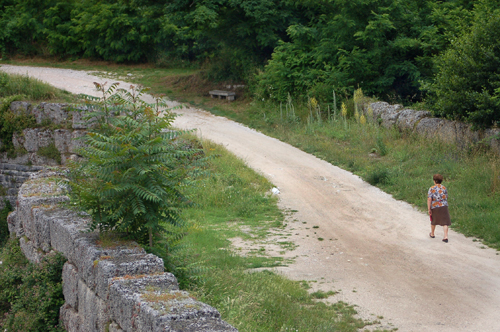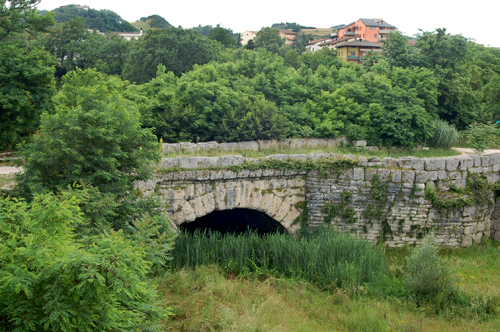Ponte Mallio, a Roman bridge from 200 B.C. near Cagli.
A bridge to the past
Rome's influence on Cagli and the Marche region
Text by Megan Pizzitola
As you drive into Cagli along the autostrada, it is easy to miss the rich history of the Via Flaminia. It may surprise most Americans, for whom hundreds of years is considered old, that people have been walking on this road and crossing the Bosso and the Burano rivers for thousands of years.
All that remains of the Roman empire is a bridge on the east edge of town. However, the Via Flaminia, a road connecting Rome to the ocean, is still used every day. Although this road was built in Roman times, its importance has transitioned throughout each period in history, with particular importance in the Renaissance. The Cagliese feel very proud that they live along this ancient road.
As the Roman Empire began to expand in 220 B.C., a decision was made to build a road from Rome to Fano and Rimini, literally, "a road to the sea" as it has been called. The Romans saw the importance of making connections, and they used their army as means of building and expanding roads. The Via Flaminia is one of Rome's earliest roads and is considered one of its most important roads as well.
Alberto Mazzacchera, the vice mayor of Cagli calls the Via Flaminia the "best and fastest road to come to the North." In his role as vice mayor, Mazzacchera must have a deep understanding of the town's history and culture. Mazzacchera is an established historian, with many books and essays on his list of accomplishments.
Other than the roads of the Via Flaminia, bridges were needed to cross rivers and valleys. Crossing the area known as Cagli today would have been very difficult without these famous Roman structures. Tunnels were also cut into the rock to make the road come through where the Romans found dead ends, such as mountains.
The road between the two regions of Marche and Umbria is the "most unique part of the road that still exists, the most incredible historical findings in terms of engineering," Mazzacchera claims. Also lying along the Via Flaminia, a Roman tunnel is still in use in the nearby town of Furlo. As a result of recent archeological discoveries, another neighboring town, Smirra has found additional Roman bridges.
The area known as Cagli today was originally called "Cale" by the Romans. Two Roman bridges built as a part of the Via Flaminia bordered a valley where the town would eventually be built. For defense, the Romans built the city between the two rivers rather than in the hills.

Roman stones from the bridge east of Cagli.
Ponte Mallio, the Roman bridge on the east edge of town, is uniquely important. It is the last piece of the Roman architecture still standing, as it was originally one of the first built. Mazzacchera beams proudly, "As you can tell, this is an important region for the Romans, which took an incredible amount of time and engineering to build."
The Romans did not use Cale for more than an army stop along the road until 295 B.C., when it began to be inhabited. The Byzantines conquered the area in the 5th century bringing even more residents to the small settlement. The importance of the area grew immensely as the Byzantines helped make it part of a pentapolis - a group of five towns that formed an alliance for defense purposes. The five towns that Mazzacchera calls the "pentapolis on the crest of the Apennine mountains" included Cagli, Jesi, Fossombrone, Urbino, and Gubbio.

Signpost with information about Ponte Mallio.
Even after the Romans left in the Middle Ages, the Via Flaminia has remained important for centuries. The current day Piazza Matteotti in the center of town was constructed on top of a Medieval cemetery. Because it was the largest open flat space, archeologists believe, the Romans used it as a forum during their occupation of Cagli. Knowing that buildings were erected on top of ruins during the Middle Ages, historians hypothesize that Roman ruins are buried deep underneath the cobblestone streets. However, excavations would be extremely expensive and risky without knowing exactly what is underneath.
The Renaissance valued the Via Flaminia as well. Mazzacchera called the road a "cultural connection" encouraging many different people from varying trades and regions to connect. Everyone from, artists, poets, writers, and pilgrims utilized the gift the Romans left. The road increased commerce so much that the average income of someone living on the road was ten times greater than the European average.
Mazzacchera used springtime as a powerful metaphor to describe the importance of the Via Flaminia through the Renaissance. The road connected people and allowed art and innovation to spread. The presence of the road allowed the Renaissance to blossom, "along this road, incredible seeds flourished."
The Cagliese are proud of living in a town with so much history.
"Talk about history," Mazzacchera says motioning up to the domed brick ceiling in his kitchen. "This used to be a place they kept the horses, and on the other side, where they kept the carriage, is now where I keep my car."
Mazzacchera also feels "an honor and a duty to maintain such a legacy," which is why there are efforts among local, provincial, and federal governments to conserve historical artifacts and buildings. However, governmental funding for preservation is considered a privilege, given only if a city has shown "respect and care" in the maintenance of cultural artifacts.
Driving along the main highway in and out of town, it is not obvious to the naked eye how much history lies underneath. The Via Flaminia is still used today, as a major road linking Rome with the Adriatic coast. It is amazing to think that a road built thousands of years ago still exists for us to use today.

A local woman crosses the Ponte Mallio.

![]()

